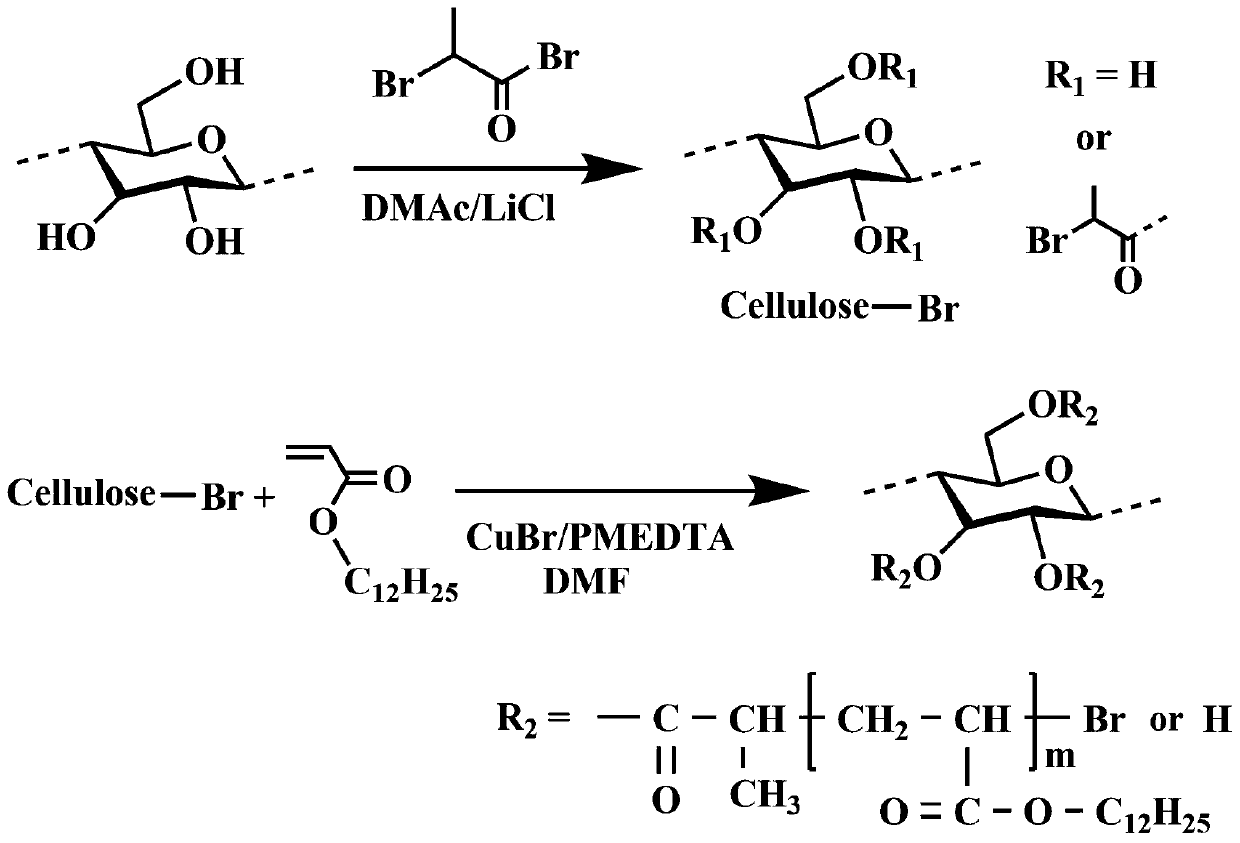GN@cellulose based solid-solid phase change material and preparation method and application thereof
A phase change material, cellulose-based technology, applied in heat exchange materials, fiber chemical characteristics, chemical instruments and methods, etc., can solve the problem of low thermal conductivity of cellulose polymer phase change materials and flexibility of graphene-based phase change materials It is not suitable for secondary processing and molding, and achieves the effects of narrow phase transition temperature range, excellent thermal cycle stability, structural controllability, and improved sensitivity
- Summary
- Abstract
- Description
- Claims
- Application Information
AI Technical Summary
Problems solved by technology
Method used
Image
Examples
preparation example Construction
[0039] The present invention also provides a preparation method of GN@cellulose-based solid-solid phase change material (referred to as the method), which is characterized in that the method includes the following steps:
[0040] (1) Cellulose dissolution: stirring and dissolving the dried cellulose in solvent A at a temperature of 65-95° C. to obtain a cellulose solution with a mass fraction of 5-15 wt %;
[0041] In step 1), the cellulose is microcrystalline cellulose, cotton pulp, cotton linters, cotton, wood pulp, bamboo pulp, cellulose filter paper or absorbent cotton;
[0042] The solvent A is a solvent capable of dissolving cellulose, specifically a mixed solution of paraformaldehyde (PF) / dimethyl sulfoxide (DMSO), a mixed solution of lithium chloride / N,N-dimethylformamide or Ionic liquid; in the mixed solution of paraformaldehyde and dimethyl sulfoxide, the mass ratio of paraformaldehyde and dimethyl sulfoxide is 1: (8~12); lithium chloride and N,N-dimethylformaldehyde...
Embodiment 1
[0065] 1) Dry the microcrystalline cellulose in a vacuum oven at 60°C for 12 hours; take the dried microcrystalline cellulose and dissolve it in dimethyl sulfoxide / paraformaldehyde (DMSO / PF) (the mass ratio of DMSO to PF is 12:1), the concentration of microcrystalline cellulose is 8wt.%, mechanically stirred at 95°C until it becomes a homogeneous system to obtain a cellulose solution;
[0066] 2) The cellulose solution is cooled to room temperature, and 2-bromopropionyl bromide is added dropwise to the cellulose solution in an ice-water bath to react, wherein the molar ratio of hydroxyl and 2-bromopropionyl bromide in the cellulose unit ring is 1:3; after the dropwise addition, place it at room temperature for 3 hours; then heat it to 50°C for 2 hours; cool the product to room temperature, add distilled water to remove unreacted raw materials and by-products, and repeatedly wash and filter to obtain the crude product; The crude product was heated and dissolved in acetone, and ...
Embodiment 2
[0075] 1) Dry the cotton fiber in a vacuum oven at 60°C for 12 hours; take the dried cotton fiber and dissolve it in 1-allyl-3-methylimidazolium chloride (AmimCl) solution, the concentration of the cotton fiber is 9wt. %, stir mechanically at 95°C until it becomes a homogeneous system to obtain a cellulose solution;
[0076] 2) Cool the cellulose solution to room temperature, and add 2-bromoisobutyryl bromide dropwise to the cellulose solution in an ice-water bath to react, wherein the molar ratio of the hydroxyl group in the cellulose unit ring to 2-bromoisobutyryl The ratio is 1:4; after the dropwise addition, put it at room temperature to react for 3 hours; then heat it to 50°C for 2 hours; cool the product to room temperature, add distilled water to remove unreacted raw materials and by-products, wash and filter repeatedly to obtain the crude product; The crude product was heated and dissolved in acetone, and distilled water was added for recrystallization and purification...
PUM
| Property | Measurement | Unit |
|---|---|---|
| melting point | aaaaa | aaaaa |
| thermal decomposition temperature | aaaaa | aaaaa |
| phase transition temperature | aaaaa | aaaaa |
Abstract
Description
Claims
Application Information
 Login to View More
Login to View More - R&D
- Intellectual Property
- Life Sciences
- Materials
- Tech Scout
- Unparalleled Data Quality
- Higher Quality Content
- 60% Fewer Hallucinations
Browse by: Latest US Patents, China's latest patents, Technical Efficacy Thesaurus, Application Domain, Technology Topic, Popular Technical Reports.
© 2025 PatSnap. All rights reserved.Legal|Privacy policy|Modern Slavery Act Transparency Statement|Sitemap|About US| Contact US: help@patsnap.com



